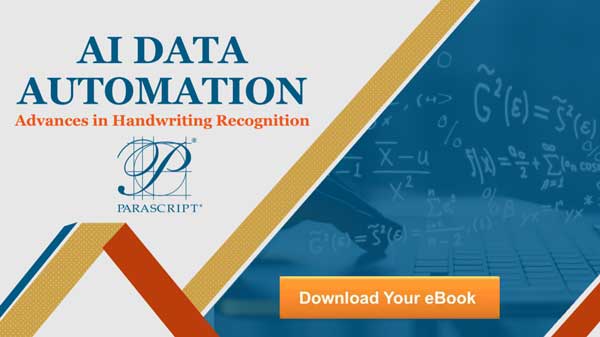One important aspect of data capture is often overlooked, and that is information found in handwriting…This means paper. According to a new study conducted by AIIM, 49% of data capture volume is paper. Paper is evenly used across most core business processes, but especially in activities like mortgage origination, new account opening, onboarding and order fulfillment—all applications that typically ask for handwritten input, comments and signatures.
Data capture systems are a popular way to digitize information that would otherwise be locked on paper. This “digitalization” of paper-based information is at the heart of digital transformation and the lifeblood of many process improvement and cost saving measures. Indeed, it is common to scan a physical page and automatically extract bits of printed information so that the newly created digital version can be more easily stored and found. This reduces paper and improves access to information—a stalwart objective for any intelligent information management strategy.
Organizations should take advantage of new handwriting recognition software, especially as demands for improved information governance increase.
ICR Handwriting Recognition Software: Transforming Dark Data
Today, organizations look for ways to shed light on hidden content in the form of handwritten information that exists on forms, contracts and other documents. Despite the desire to be digital-first, the truth is that a great number of business forms and documents still contain handwritten entries. These replies, notes and signatures are all vitally important from both a risk and an opportunity point of view.
Legal discovery, privacy, compliance, process improvement, archival and retention, and a host of other aspects and applications all can now leverage handwritten information to not only reduce risk to the organization, but also bring new opportunities that may have never been considered in the past. Here are a few examples.
- Unconstrained and Constrained Handprint. Reading and extracting data from constrained handprint or handwriting in a box or other defined document area (commonly called intelligent character recognition or ICR) is the most straightforward handwriting recognition activity. Unconstrained handprint is handwritten content not confined to a predetermined area in a document that more advanced ICR converts into data records with a high level of accuracy.
- Cursive Handwriting. A great deal of important information is contained in cursive handwriting or a mix of handprint and writing that looks like cursive, yet most of this data is overlooked or lost in the capture and archive process. Advanced ICR software reproduces a human’s ability to instantly apply context and judgment in a mechanized process to address issues of nonstandard elements such as writing outside form boxes and accommodating handwriting variances with minimal human intervention. This is important so that comments on forms such as “this product is defective,” or “response was incredibly positive” are not lost and provide powerful insights to improve products, services and performance.
- Signatures – The completion of many key business processes often comes down to a handwritten signature. Loans, leases and contracts, for example, all require a signature; and often that means ink on paper. Organizations are subject to legal discovery demands to locate and retrieve documents that were signed by a certain individual.
New Deep Learning Handwriting Recognizers
Advanced capture software can help organizations from all industries capture overlooked handwritten information and use that information in intelligent ways. One tool is the handwriting recognition software from Parascript called FormXtra.AI. This self-learning document automation software includes new deep learning handwriting recognizers that effectively capture hidden data, and incorporates machine learning-based analysis into its unique features. There are indeed a number of important capabilities, but the handwriting recognition feature is certainly one that will unlock new value and advantage for organizations looking to capture handwritten data.
Advanced ICR software can perform automated recognition on constrained handprint, unconstrained handprint and cursive handwriting. With a virtually unlimited number of writing styles, ICR accuracy levels can be impacted by content quality such as high noise levels and intrusions in the image, content that is illegible and character ambiguity regarding how specific letters are written. Even so, accuracy levels for more advanced handwriting recognition software have improved significantly with the application of deep learning handwriting recognizers.
Moving Forward
Today’s capabilities are a far cry from ICR technologies that came out over a decade ago. Organizations should take advantage of advanced ICR handwriting recognition software, especially as demands for improved information governance increase. Otherwise, they may be exposed to more risk and cost, and missed opportunities to optimize the performance of the firm. Handwritten data and free-format fields play an important role as organizations seek to exploit the “Big Data” they may contain. Look for providers and partners with the right mix of expertise, capability and vision so that you can make the most of handwriting recognition.
###
Guest contributor Kevin Craine is the author of the book Designing a Document Strategy and host of the Document Strategy Podcast. He is the managing director of Craine Communications Group. For more information visit CraineGroup.com.
If you found this article interesting, you might find the following ebook of interest, AI Data Automation: Advances in Handwriting Recognition.





